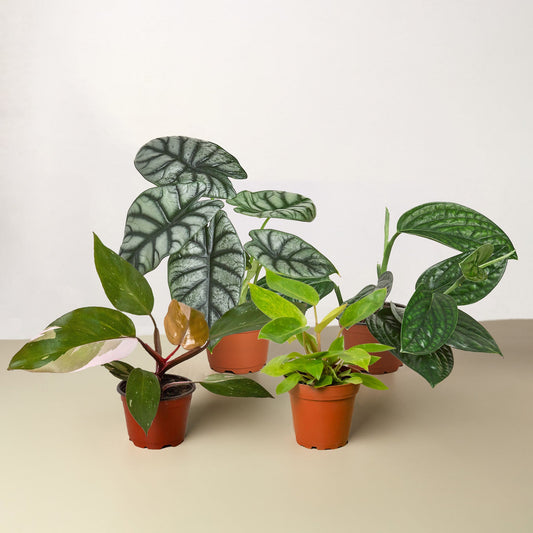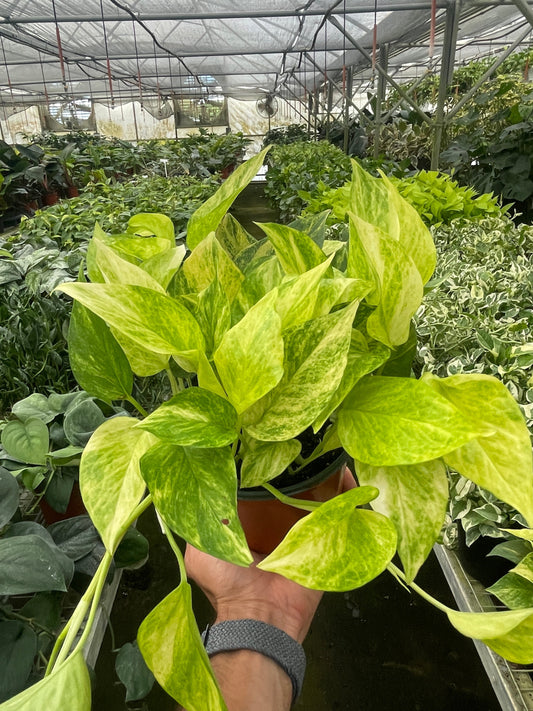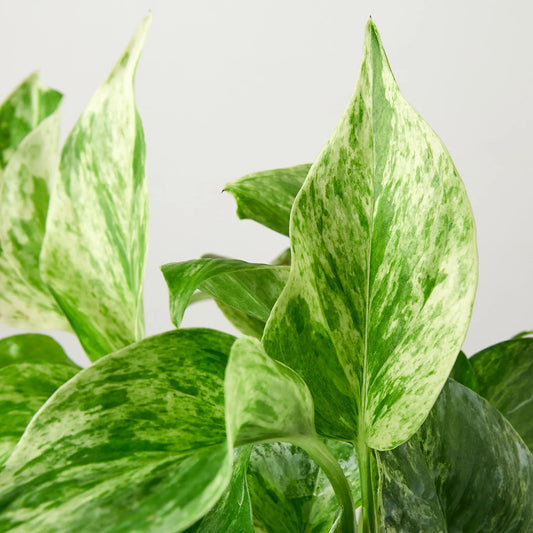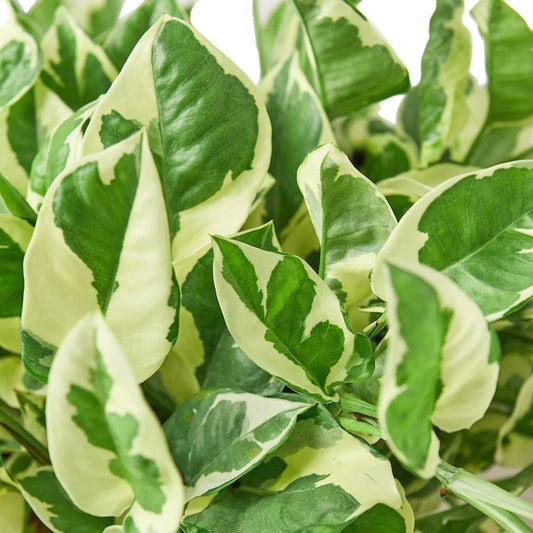Cyclamen Aerial Roots: Everything You Need to Know
Cafe Planta Team
If you're a fan of houseplants, you've likely encountered the cyclamen, a charming plant known for its vibrant flowers and heart-shaped leaves. But beyond its surface beauty, there's a curious feature that often goes unnoticed or misunderstood: its aerial roots. These quirky little roots can be a bit of a mystery, even to seasoned plant lovers. Let's unravel the secrets behind these fascinating features and see how they play a role in your cyclamen's health and care.
In this article, we'll touch on the nature of aerial roots, why cyclamens have them, and how you can use this knowledge to keep your plant thriving. We'll also cover practical tips on caring for these roots and integrating cyclamens into your home design. Ready to dig in? Let's get started!
What Are Aerial Roots?
Aerial roots are a curious phenomenon. Unlike typical roots, which anchor plants into the soil and absorb water and nutrients, aerial roots grow above the ground. They can be found in a variety of plant species, often serving different purposes, from providing support to absorbing moisture from the air.
In cyclamens, these roots can emerge from the tuber and sprout upwards, sometimes giving the plant an almost whimsical appearance. While they might look a bit strange, they're a natural part of the plant's growth process. These roots are not a sign of distress but rather an adaptation that can help the plant thrive in its environment.
Interestingly, aerial roots can also act as a secondary means of nutrient absorption, especially in humid environments. They can soak up moisture from the air, which is particularly useful for epiphytic plants that grow on other surfaces rather than in the soil. But for cyclamens, these roots primarily aid in stabilization and sometimes help the plant manage excess moisture.
Why Do Cyclamens Have Aerial Roots?
You might be wondering why cyclamens, which are typically planted in soil, sport these aerial roots. The answer lies in their natural habitat and growth habits. Cyclamens are native to regions where the soil can vary from very dry to quite moist. This variability in moisture levels is one reason why they've adapted to sprout aerial roots.
These roots can help manage water intake. In situations where the soil is too wet, aerial roots can assist in aerating the plant's root system, preventing rot by allowing excess moisture to evaporate more effectively. It's a clever adaptation that helps the plant survive in less-than-ideal conditions.
Moreover, in their native habitats, cyclamens often grow in rocky, well-drained soils. The presence of aerial roots can give them extra stability in such environments, where the soil might not provide a firm anchor. This feature is especially useful when the plant is growing on uneven or rocky surfaces.
How to Care for Cyclamen Aerial Roots
Now that we know why cyclamens have aerial roots, let's talk about how to care for them. These roots don't need a lot of extra attention, but there are a few things you can do to ensure they're healthy and happy.
First and foremost, avoid overwatering your cyclamen. The presence of aerial roots can be a sign that the plant is trying to cope with excess moisture. Make sure the soil is well-draining and that the pot has adequate drainage holes. Water the plant only when the top inch of soil feels dry to the touch.
Additionally, if your home is very dry, consider increasing humidity to help the aerial roots function optimally. You can do this by placing a humidifier nearby or by setting the pot on a tray filled with pebbles and water. Just make sure the bottom of the pot isn't sitting directly in the water, as this can lead to root rot.
Finally, be gentle with these roots. Avoid disturbing them as much as possible. If they become too dry or brittle, mist them lightly with water to keep them supple.
Repotting Your Cyclamen
When it comes to repotting cyclamens, aerial roots require a bit of extra care. These plants typically need repotting every couple of years, ideally in the spring after their blooming period is over.
To start, gently remove the plant from its pot, taking care not to damage the roots. If the aerial roots have extended significantly, you might need to use a slightly larger pot to accommodate them without forcing them back into the soil.
Use a well-draining potting mix, such as one designed for African violets, which provides the right balance of moisture retention and aeration. As you place the cyclamen in its new pot, let the aerial roots remain above the soil. This allows them to function as intended without risk of rot.
After repotting, give the plant a thorough watering and place it in a spot with indirect light. Cyclamens prefer cooler temperatures, so avoid placing them in direct sunlight or near heat sources.
Integrating Cyclamens into Your Home Design
Cyclamens are not just practical plants; they're also stunning additions to any home. With their vibrant blooms and unique aerial roots, they can be a focal point or a charming accent in your interior design.
Consider placing cyclamens in decorative containers that complement your home's style. Their lush foliage and colorful flowers look especially striking against neutral backdrops or among other green plants.
Additionally, you can use cyclamens to add a pop of color in unexpected places. Try placing them on windowsills, coffee tables, or even as a centerpiece on your dining table. Just ensure they get enough light and aren't exposed to too much heat or direct sunlight.
For a more whimsical look, consider pairing cyclamens with other plants that have interesting root structures or foliage. This can create a mini indoor garden that showcases the diversity and beauty of plant life.
Common Issues and Troubleshooting
Like any plant, cyclamens can encounter a few problems, but with some know-how, they're generally easy to resolve. One common issue is yellowing leaves, which can be a sign of overwatering or poor drainage.
If you notice this, check the soil moisture and drainage. Adjust your watering schedule if necessary, and make sure the pot is draining properly. If the roots are sitting in water, they can develop root rot, which is detrimental to the plant.
Another issue to watch out for is mold or mildew on the soil surface. This often occurs in high humidity environments or when the plant is overwatered. To combat this, ensure good air circulation around the plant and reduce watering frequency. Removing any dead or decaying leaves can also help improve air circulation and reduce mold risks.
Pests like aphids and spider mites can occasionally cause trouble, too. If you spot these pests, a gentle solution of water and dish soap can be sprayed on the affected areas to remove them. Always test any solution on a small area of the plant first to ensure it doesn't cause damage.
Propagating Cyclamens
If you’re feeling adventurous, you might want to try propagating your cyclamen. While it can be a bit challenging, it’s a rewarding way to expand your plant collection. Cyclamens can be propagated through seed or by dividing the tubers.
For seed propagation, collect seeds from the plant after the flowering period. Plant them in a seed-starting mix and keep them moist and warm until they sprout. This method requires patience, as it can take several months for seeds to germinate.
Dividing tubers is another method, but it requires careful handling. You’ll need to cut the tubers into sections, ensuring each piece has at least one growth node. Plant these sections in a well-draining mix, and keep them in a cool, shaded area until they establish.
Remember, propagation success can vary, so don’t be discouraged if your first attempts aren’t perfect. With practice, you’ll likely see better results over time.
The Role of Cyclamens in Cultural and Historical Contexts
Did you know that cyclamens have been cherished for centuries? These plants have a rich cultural and historical significance, often symbolizing love and affection. In some cultures, cyclamens were given as tokens of friendship or as gifts to express romantic interest.
Their unique ability to thrive in challenging conditions also made them symbols of resilience and hope. In ancient times, they were even believed to have protective properties, and people used them in rituals to ward off negative energies.
Today, cyclamens continue to be popular gift plants, especially during the winter months when their bright blooms can bring cheer to any home. Their enduring popularity is a testament to their beauty and the joy they bring to plant lovers around the world.
Choosing the Right Cyclamen for Your Space
Selecting the right cyclamen for your home involves more than just picking a color you like. Consider the size and growth habit of the plant, as well as the conditions in your home.
Miniature cyclamens are perfect for smaller spaces or for grouping together in arrangements. They’re compact and can fit on small shelves or windowsills. Standard cyclamens, on the other hand, have larger blooms and can make a statement on their own.
When shopping for cyclamens, look for plants with healthy, vibrant leaves and plenty of buds. This indicates a healthy plant that will continue to bloom. Avoid plants with yellowing leaves or signs of damage, as these might be stressed or unhealthy.
Ultimately, the right cyclamen for you is one that fits your style and space while thriving in your home’s environment. With the right care, these delightful plants can bring beauty and joy to any room.
Final Thoughts
Cyclamen aerial roots might seem like a small detail, but they play an important role in the health and growth of these charming plants. By understanding and caring for these unique features, you can help your cyclamen thrive and continue to brighten your home with its vibrant blooms.
At Cafe Planta, we love sharing our passion for plants and helping you create a beautiful, thriving plant collection. If you have any questions or need advice, don't hesitate to reach out via email or our Instagram. Whether you're a seasoned plant parent or new to the world of houseplants, we're here to support you on your plant journey!



















